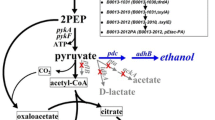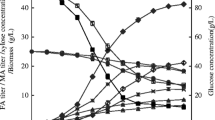Abstract
The microbial fermentation of malic acid, which is one of the most important organic acid platforms used widely in food and chemical engineering, has attracted considerable interest. A malate production strain was isolated, a mutation was induced, and regulation of the metabolic network was then conducted. The identification results showed that the malic acid production strain, HF- 119, belonged to Rhizopus delemar. An analysis of the metabolic pathway showed that the malic acid flux of this strain occurred through three main pathways, and many byproducts, such as succinic acid, fumaric acid and ethanol, were produced. Although corn straw hydrolyte was used, the metabolism of xylose was not as rapid as that of glucose. Subsequently, breeding of the strains and regulation of the metabolic network resulted in an increase in malate yield, and the strain HF-121 produced more than 120 g/L malic acid within 60 h. The ability to produce malic acid from biomass hydrolyte highlights the industrial development potential of this strain.
Similar content being viewed by others

Refrerences
Orjuela, A., A. Orjuela, C. T. Lira, and D. J. Miller (2013) A novel process for recovery of fermentation-derived succinic acid: Process design and economic analysis. Bioresour. Technol. 139: 235–241.
Nakayama, S., K. Tabata, T. Oba, K. Kusumoto, S. Mitsuiki, T. Kadokura, and A. Nakazato (2012) Characteristics of the high malic acid production mechanism in Saccharomyces cerevisiae sake yeast strain No. 28. J. Biosci. Bioeng. 114: 281–285.
Oba, T., H. Suenaga, S. Nakayama, S. Mitsuiki, H. Kitagaki, K. Tashiro, and S. Kuhara (2011) Properties of a high malic acidproducing strain of Saccharomyces cerevisiae isolated from sake mash. Biosci. Biotechnol. Biochem. 75: 2025–2029.
Zhang, X., X. Wang, K. T. Shanmugam, and L. O. Ingram (2011) L-malate production by metabolically engineered Escherichia coli. Appl. Environ. Microbiol. 77: 427–434.
Han, L. J., Q. J. Yan, X. Y. Liu, and J. Y. Hu (2002) Straw resources and their utilization in China. Transactions of the CSAE. 18: 87–91.
Battat, E., Y. Peleg, A. Bercovitz, J. S. Rokem, and I. Goldberg (1991) Optimization of L-malic acid production by Aspergillus flavus in a stirred fermentor. Biotechnol. Bioeng. 37: 1108–1116.
Taing, O. and K. Taing (2007) Production of malic and succinic acids by sugar-tolerant yeast Zygosaccharomyces rouxii. Eur. Food. Res. Technol. 224: 343–347.
Zelle, R. M., E. Hulster, W. A. Winden, P. Waard, C. Dijkema, A. A. Winkler, J. M. Geertman, J. P. van Dijken, J. T. Pronk, and A. J. van Maris (2008) Malic acid production by Saccharomyces cerevisiae: Engineering of pyruvate carboxylation, oxaloacetate reduction, and malate export. Appl. Environ. Microbiol. 74: 2766–2777.
Brown, S. H., L. Bashkirova, R. Berka, T. Chandler, T. Doty, K. McCall, M. McCulloch, S. McFarland, S. Thompson, D. Yaver, and A. Berry (2013) Metabolic engineering of Aspergillus oryzae NRRL 3488 for increased production of L-malic acid. Appl. Microbiol. Biotechnol. 97: 8903–8912.
Abe, A., Y. Oda, K. Asano, and T. Sone (2007) Rhizopus delemar is the proper name for Rhizopus oryzae fumaric-malic acid producers. Mycologia. 99: 714–722.
Bradford, M. M. (1976) A rapid and sensitive method for the quantitation of microgram quantities of protein utilizing the principle of protein-dye binding. Anal. Biochem. 72: 248–254.
Kregiel, D., J. Berlowska, and W. Ambroziak (2008) Succinate dehydrogenase activity assay in situ with blue tetrazolium salt in crabtree-positive Saccharomyces cerevisiae strain. Food Technol. Biotechnol. 46: 376–380.
Friedberg, D., Y. Peleg, A. Monsonego, S. Maissi, E. Battat, and I. Goldberg (1995) The fumR gene encoding fumarase in the filamentous fungus Rhizopus oryzae: Cloning, structure and expression. Gene. 163: 139–144.
Payne, J. and J. G. Morris (1969) Pyruvate carboxylase in Rhodopseudomonas spheroides. J. Gen. Microbiol. 59: 97–101.
Nielsen, J. (2001) Metabolic engineering. Appl. Microbiol. Biotechnol. 55: 263–283.
Riascosa, C., A. K. Gomberta, and J. M. Pintoa (2005) A global optimization approach for metabolic flux analysis based on labeling balances. Comput. Chem. Eng. 29: 447–458.
Skory, C. D., S. N. Freer, and R. J. Bothast (1998) Production of L-lactic acid by Rhizopus oryzae under oxygen limiting conditions. Biotechnol. Lett. 20: 191–194.
Liu, Y. P., P. Zheng, Y. Ni, J. J. Dong, P. Wei, and Z. H. Sun (2008) Breeding of Monofluoroacetate-resistant Strains of Actinobacillus succinogenes and the mechanism based on metabolic flux analysis. Chin. J. Biotechnol. 24: 460–467.
Dhillon, G. S., S. K. Brar, M. Verma, and R. D. Tyagi (2011) Recent advances in citric acid bio-production and recovery. Food Bioproc. Tech. 4: 505–529.
Miura, S., T. Arimura, L. D. Itoda, J. B. Feng, G. H. Bin, and M. Okabe (2004) Production of L-lactic acid from corncob. J. Biosci. Bioeng. 97: 153–157.
McKinlay, J. B., Y. Shachar-Hill, J. G. Zeikus, and C. Vieille (2007) Determining Actinobacillus succinogenes metabolic pathways and fluxes by NMR and GC-MS analysis of 13C-labeled metabolic product isotopomers. Metab. Eng. 9: 177–192.
Szyperski, T. (1995) Biosynthetically directed fractional 13Clabeling of proteinogenic amino acids: An efficient analytical tool to investigate intermediary metabolism. Eur. J. Biochem. 232: 433–448.
Longacre, A., J. M. Reimers, J. E. Gannon, and B. E. Wright (1997) Flux analysis of glucose metabolism in Rhizopus oryzae for the purpose of increasing lactate yields. Fungal. Genet. Biol. 21: 30–39.
Santamaria, B., A. M. Estevez, O. H. Martinez-Costa, and J. J. Aragon (2002) Creation of an allosteric phosphofructokinase starting with a nonallosteric enzyme: The case of dictyostelium discoideum phosphofructokinase. J. Biol. Chem. 277: 1210–1216.
Author information
Authors and Affiliations
Corresponding author
Rights and permissions
About this article
Cite this article
Li, X., Liu, Y., Yang, Y. et al. High levels of malic acid production by the bioconversion of corn straw hydrolyte using an isolated Rhizopus delemar strain. Biotechnol Bioproc E 19, 478–492 (2014). https://doi.org/10.1007/s12257-014-0047-z
Received:
Revised:
Accepted:
Published:
Issue Date:
DOI: https://doi.org/10.1007/s12257-014-0047-z



